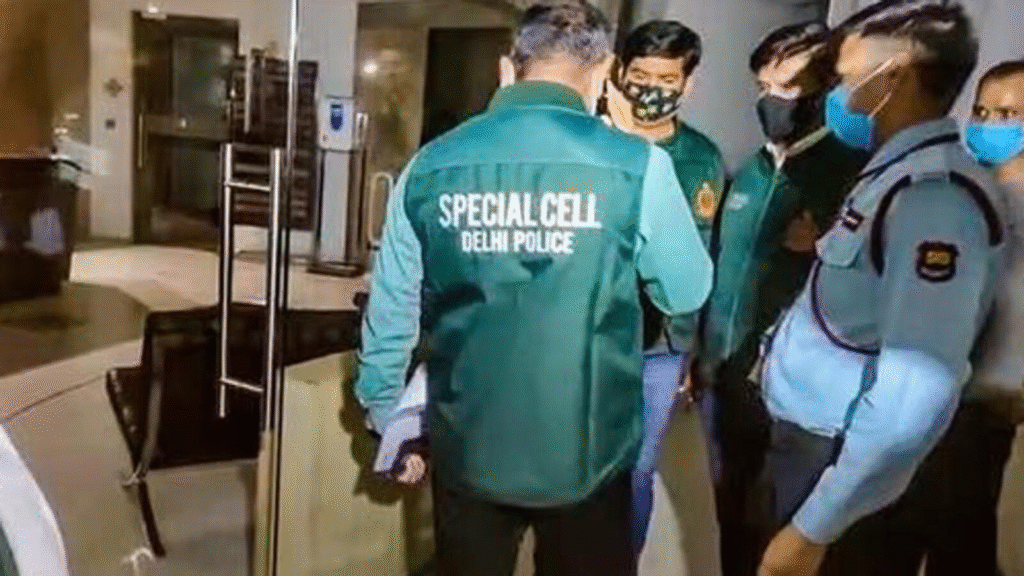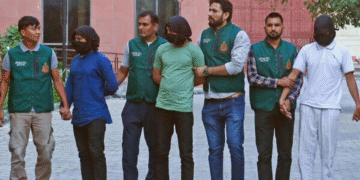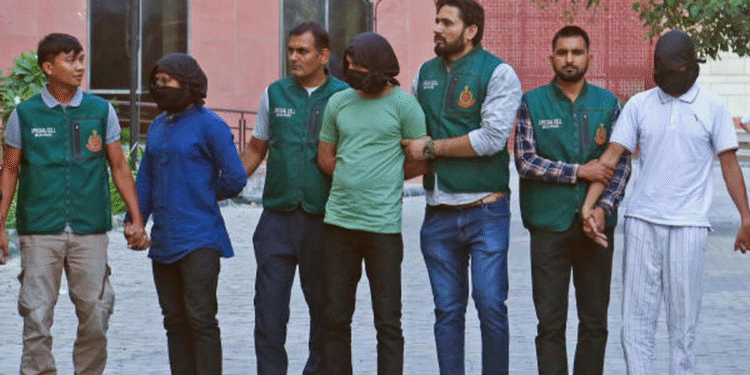Major terror attack averted: Delhi Police’s Special Cell has busted an Islamic State-inspired module in the national capital, arresting two suspected terrorists and seizing bomb-making material as investigations reveal cross-border links
New Delhi, October 24, 2025 – In a major counter-terror operation early today, the Delhi Police Special Cell successfully foiled what investigators believe was a planned large-scale terror attack in the national capital region. Two suspected members of an ISIS-inspired terror module were arrested after simultaneous raids, and substantial bomb-making material and electronic components were seized from their hideout.
The Operation
According to official sources, intelligence agencies had picked up suspicious chatter and activity over the past few weeks indicating a terror cell operating under the ideological influence of the Islamic State (IS) and possibly receiving directions from overseas handlers. This triggered a coordinated operation by the Special Cell, aided by central intelligence agencies.
In the early hours of the morning, teams swooped on multiple locations in Delhi. Two suspects were apprehended — their names are being withheld pending legal process. In the course of the raid, police recovered a large cache of materials including:
- Motherboards, circuit boards and electronic components.
- Chemical precursors such as acids, sulphur powder and other substances consistent with IED fabrication.
- Ball-bearings, safety gloves, a weighing machine and other implements indicating training or workshop like setup.
Officers described the site as a “classroom of bombs” — indicating that the module was perhaps training or preparing to produce improvised explosive devices (IEDs) rather than simply executing a single operation.

Scope and Significance
The arrests mark a significant success for Indian security agencies, given the advanced stage at which the module apparently had reached. Investigators said the suspects had been planning their activities for months and were targeting high-foot-traffic locations in the Delhi region. The seizure of both chemical and electronic components suggests a level of sophistication beyond street-level terror operations.
Furthermore, clear cross-border links have emerged. Parts of the inquiry indicate coordination with handlers outside India, possibly linked to the Pakistani intelligence architecture working with radicalised cells.
What We Know So Far
- The operation was led by the Special Cell under Additional Commissioner (Special Cell) Pramod Kushwaha.
- Two suspects have been formally arrested so far; several more are believed to have been detained and are under interrogation.
- Materials seized indicate a multi-state reach of the module, with hideouts and logistics possibly spread across states such as Jharkhand, Maharashtra, Telangana and Karnataka.
- The modus operandi appears to include recruitment of youth, use of encrypted messaging apps (Signal, Telegram) and self-radicalisation via online content.
Behind the Scenes: How the Cell Operated
Investigators are piecing together a network that worked roughly as follows:
- Ideological Anchor: The module claimed inspiration from IS and its agenda of establishing a caliphate (the “Ghazwa-e-Hind” narrative) to drive recruitment and radicalisation.
- Training & Logistics: The suspects appear to have conducted training in the fabrication of IEDs. Seized items such as ball bearings, pH value-checkers and circuit boards are indicative of devices aimed at maximising blast effect.
- Encrypted Communications: The module used encrypted apps to communicate with handlers abroad, coordinate logistics of chemical and electronic shipment.
- Cover Activities: Some operatives posed as students, job-seekers or small-business owners to deflect suspicion and arrange funds & materials covertly. Reports mention one suspect from a Jharkhand district who had posed as an English graduate staying in a lodge.
- Target Selection: According to sources, high-profile public spaces in the Delhi-NCR region were shortlisted for attack — malls, metro stations, airports or religious gatherings — places that would deliver maximum impact.
Why It Matters
This bust is crucial for several reasons:
- Prevention of mass casualties: At an advanced stage of attack planning, the module had the capacity to mount a large‐scale strike. Its disruption likely saved many lives.
- Hybrid threat model: The evolving threat is not just from known militant groups but from self-radicalised, loosely networked modules inspired by IS, with global reach.
- Technology & chemistry confluence: The combination of electronic triggers, chemical explosives, online radicalisation and real-world logistics signals a dangerous convergence of methods.
- Cross-border coordination: The presence of handlers outside India underlines the need for stronger international intelligence cooperation.
- Youth recruitment & radicalisation: The case shows how impressionable youth can be drawn into terror networks via social media, posing a societal challenge beyond policing.
What Happens Next
- Detailed forensic analysis: All seized material (chemicals, electronics, digital devices) will undergo forensic scrutiny to map the chain of procurement, trace the supply route and link handlers.
- Interrogation & network mapping: The two arrested suspects will be closely questioned. Authorities will attempt to reveal the full network: financiers, logistic facilitators, radicalisers, handlers abroad.
- Multi-agency coordination: The case will likely see input from agencies including the National Investigation Agency (NIA), Intelligence Bureau (IB), state Anti-Terror Squads (ATS) and customs/port authorities.
- Public & private vigilance: Security in public spaces in Delhi-NCR is likely to increase. Private stakeholders (malls, metros, airports) may be asked to review their evacuation/emergency response protocols.
- Legal & policy consequences: The case could lead to policy review on social-media monitoring, radicalisation prevention frameworks, tighter control of precursor chemicals and stricter oversight of long-term lodgings used as safe-houses.
Voices From the Ground
Officials from the Delhi Police have avoided giving full operational details, citing security concerns. However, one senior officer remarked, “The length and sophistication of what the module was preparing for meant we were dealing with a cell that could have created mass destruction. The success lies in the quiet precision of the raid rather than a dramatic firefight.”
From the civil society perspective, a counter-terrorism analyst said:
“This is a textbook case of the evolved terror-threat model: locally-embedded operatives + online radicalisation + cross-border handlers + hybrid bomb-making. It underscores that India cannot fight only conventional terrorist organisations — the threat matrix is changing.”
Broader Implications for India’s Security
- Rise of IS-inspired modules: While groups like IS may have lost territory abroad, the ideology continues to inspire and spawn smaller self-directed modules around the world — including India. This makes detection harder, as there is no single obvious organisation to target.
- Need for asynchronous policing: The threat requires coordinated action between intelligence, local police, state ATS, customs, digital-forensic agencies and international liaison.
- Capacity building in non-traditional terror prevention: Focus on materials (chemicals, electronics), financial monitoring, social-media content and youth outreach is becoming as critical as classic law-enforcement.
- Community involvement: Prevention of radicalisation, spotting vulnerable youth, ensuring support systems and counter-narratives become important complementary tools to policing.
- Global dimension: The mention of overseas handlers and material supply shows that domestic security cannot be viewed in isolation — international cooperation on intelligence, extradition, border control, cyber-monitoring remains essential.
Key Questions Going Forward
- How many suspects remain at large in this module?
- What specific target(s) did the module plan to attack, and how advanced was the plot?
- What was the exact role of the overseas handler(s), and from which country or network did direction come?
- What were the financial flows, procurement chains and safe-houses used?
- What policy or procedural gaps (if any) allowed the module to become operational in Delhi?
- What support and outreach measures will be introduced to prevent similar radicals from emerging?
Conclusion
Today’s operation by the Delhi Police Special Cell signals a decisive victory in counter-terror efforts and highlights the evolving nature of terror threats facing India. Two terrorists apprehended, bomb-manufacturing materials seized, and potentially a large-scale atrocity prevented — the stakes could not have been higher.
Yet the success also comes with a warning: extremist ideologies morph, adapt and localise themselves. As the country moves ahead, the focus must remain not only on reacting to terror but on anticipating the next evolution, strengthening preventive infrastructure, and engaging both state-actors and society in the fight against radicalisation.
For now, thanks to swift intelligence work, coordination and swift action, Delhi remains safe from what could have been a devastating terror incident. But vigilance must remain constant.
Also Read : 21 killed as Hyderabad-Bengaluru private bus catches fire in Andhra; Police collect DNA from charred bodies















 Categories
Categories









